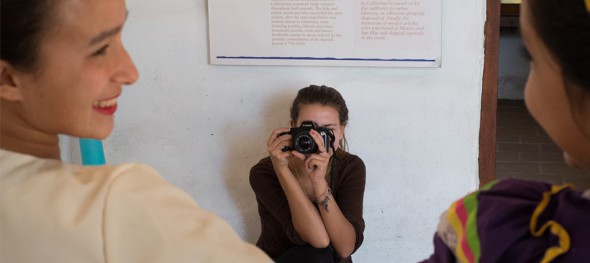From the Anacapa Visual Arts Department

Photography
I’m writing on a Tuesday night, having taught Photography today. Our class looked like this: the students who are new to Photography this semester got a lecture on the elements of design and composition. Then they looked at an Henri Cartier Bresson book to spot those elements in his work. Meanwhile, at the other side of the classroom, the students who have taken Photography before set up a light kit and used Key, Fill and Background lights to create and shoot portrait lighting patterns they’ve learned, as well as experimenting with generating their own patterns. They shared the results with the new students, and we talked about how to study an individual’s face and light it to best advantage. Then, while some students downloaded their work to Lightroom and worked on their editing skills, others studied the wide-ranging portrait work that was in the Santa Barbara Art Museum’s “Portrayal/Betrayal” exhibit. And there you have an example of the hands-on, fluid and flexible learning that is possible when you have an Anacapa-sized class of seven students and plenty of resources for all to use. Drop by on another day and you may join us on a planned, or sometimes impromptu, field trip!
~ ~ Alison Strelich
Ceramics
Recently, the Anacapa Ceramics class was on FIRE! With the assistance of our neighbor and creative ceramic artist Armando De La Rocha, our students participated and assisted in a RAKU firing at Anacapa. Raku is a traditional Japanese low-firing method in which molten hot glazed pieces are removed from the kiln with long metal tongs and then placed in metal containers with combustible materials. The material sparks, catching fire briefly before the container lid is placed back on, putting out the fire and smoking the ceramic piece.
Being inspired by the work of modern artists Robert Arneson, Amedeo Modigliani, and others, we also looked at the work of Picasso to create abstract clay collage pots and rearranged self-portraits bowls. By using the Raku method, we wove together this ancient firing technique with contemporary pottery. The results were exciting! Luster, luminescence, and creative beauty—now that is the essence of the Anacapa experience!
~ ~ Paula Campanelli
Studio Art and Art of the World
Let me start by admitting unabashedly that I love teaching art! Creating something on your own that is aesthetically pleasing is empowering, and gaining technical skills in the arts can be very gratifying. I get to explain to our students how something can be done and then watch them take it from there; I also get to share in their excitement about their artistic accomplishments, which is wonderful. But what I really love about my job as art teacher is how art offers students so many opportunities to learn much more than how to create lovely things—with each new project, the students get to practice and build proficiency in both artistic and life skills.
One recent project in Art of the World has been pique assiette, where small pieces of broken ceramics are attached to another surface and grouted to form a very durable mosaic image. It is an artistic version of recycling that dates back to ancient Roman times! Before starting, I talked about how important contrast is for differentiating the different elements of their design and why the tiny pieces of the medium work better with a bold design versus a more complicated one. Then I gave some safety admonishments, and the students began. They have had a wonderful time smashing and cutting up colorful plates that I get from thrift stores (there aren’t a lot of times in school when a student is asked to start out by breaking something!) and then carefully assembling the pieces—first imagining their design and trying it out and then adjusting it or adding to it because they saw a great color combination someone else was using, and maybe even starting over completely because a piece rolled off the table and broke. The pique assiette project has been an opportunity for students to learn some artistic vocabulary (contrast and bold) plus many, many important life skills (how it feels to challenge oneself, to commit to something, to make mistakes and then to build resiliency by moving past those mistakes, and to learn from and appreciate how other people do things).
Making art isn’t always easy, but the benefits are tremendous. Art may not have the kind of practical usefulness that understanding percentages does, and it isn’t rocket science that can propel us into the future, plus art is often just plain messy; however, it is very clear that art teaches students a lot of skills that will be useful in many areas of their lives. We look forward to sharing the students’ fine work at the spring art show.
~ ~ Suzie Sichi
